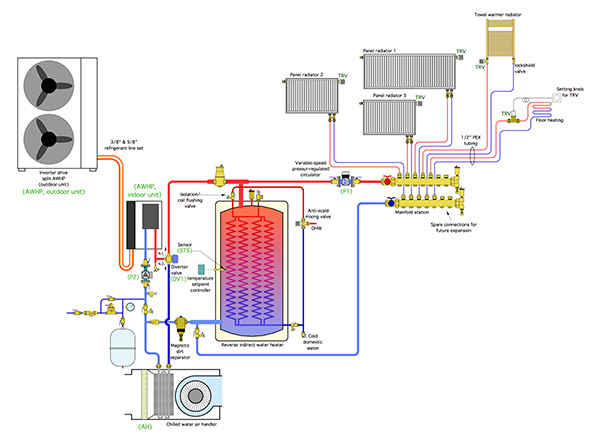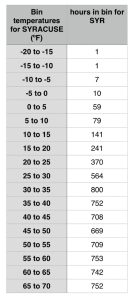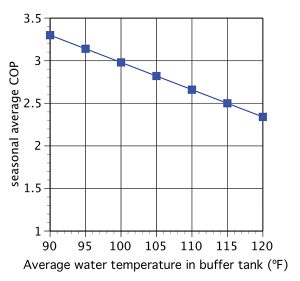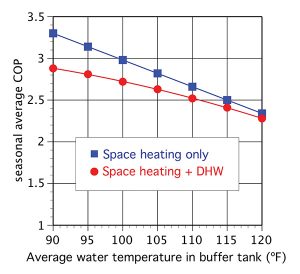
Which is Better?
March 9, 2022 | By John Siegenthaler
Considering various control options when combining domestic hot water plus space heating in colder climates using an air-to-water heat pump with your hydronics system.

Figure 1. Example of an air-to-water heat pump providing space heating/cooling and DHW.
One of the advantages of air-to-water heat pumps is their ability to provide space heating, cooling, and domestic water heating. The system shown above in Figure 1 is a “template” for such a system.
When operating in heating mode the heat pump maintains the water in the buffer tank at an elevated temperature suitable for space heating and at least a portion of the domestic hot water (DHW) heating load. The reverse indirect tank provides buffering between the heat pump’s heat output rate and the variable space heating load created by five independently controlled zones of heat emitters. Domestic water absorbs heat as it passes through the copper or stainless-steel coils suspended within the buffer tank.
Tradeoffs
The combination of space heating and DHW sets up a bit of a “quandary.” To optimize the heat pump’s coefficient of performance (COP) the water in the buffer tank should only be heated to the minimum temperature necessary to maintain comfort in the building. That’s easily accomplished using a properly set up, and relatively inexpensive, outdoor reset controller. Some modern air-to-water (ATW) heat pumps even have this control logic included within their internal controls.
However, to optimize the use of heat pump energy for DHW the tank temperature should be maintained at a temperature of at least 120F (49C) at all times. This is based on a nominal five-degree temperature loss across the heat exchanger coils and assumes that DHW delivered from the tank at 115F (46C) is acceptable.
Lower tank temperatures will reduce the percentage of heat supplied to domestic water from the heat pump, and thus increase the amount of heat the needed from a supplemental heat source.
Here’s the “quandary”: Is it better to use outdoor reset to control the tank water temperature and take the “penalty” in the form of increased supplemental heating for domestic water heating, or should the heat pump maintain the tank temperature high enough to meet the DHW load 24/7, and take the “hit” of a lower seasonal COP?
Complex Solution
That’s a complex question to answer. It involves specifics for the DHW load relative to space heating load, the COP and heating capacity performance of the heat pump, and the regional climate the system operates in. It also involves the relative cost of installing a dual function buffer tank versus a single function buffer, and the cost of installing a means of providing supplemental heat for boosting DHW to a desired delivery temperature.
The Model
To get a quantitative assessment of these factors I set up a spreadsheet simulation that melds much of this information together. It produced results that seem reasonable given the relatively simple modeling methods used. I’ll share those results with you shortly. First let’s put the “givens” out there along with the “assumptions.”
The spreadsheet simulation is based on a specific heat pump, in this case a nominal 5-ton (@60,000 Btu/h) unit with “low ambient” refrigeration system enabling it to operate at outdoor air temperatures as low as -22F (-30C). The heating capacity and COP of this heat pump, like any ATW heat pump, are highly dependent on operating conditions, specifically outdoor air temperature and the water temperature leaving the heat pump’s condenser. That dependency was modeled using data provided by the manufacturer to create “curve fit” equations that were implemented in the spreadsheet.
The building modeled was a single-family home with a design heat loss of 36,000 Btu/h based on 70F (21C) inside and -10F (-23C) outside temperatures. This home’s hydronic distribution system serves a combination of panel radiators and radiant floor circuits. The heat emitters were sized for a design load using 110F (43C) supply water temperature.
The system’s assumed location was Syracuse, NY (about a 3-hour drive east of Niagara Falls). The simulation used long term “bin” temperature data, as shown in Figure 2.

Figure 2. Long term “bin” temperature data for northern New York state.
Bin temperature data organizes the hourly average outdoor temperature, at a given location, into groups that, in this case, are five-degrees Fahrenheit “wide.” For example, Figure 2 shows that the long-term average outdoor temperature in Syracuse is between 5F and 10F for 79 hours per year. Bin temperature tabulations are available from multiple sources including ASHRAE and ACCA Manual J. The bin temperature data drives the space heating load model as well as the performance model for the heat pump heating capacity and COP.
Space heating only
I modeled several scenarios involving different average buffer tank temperatures. I wanted to see how these temperatures affected the seasonal average COP of the heat pump. The results (Figure 3) show that the seasonal average COP of this particular heat pump, as expected, will vary depending on the water temperature of the space heating distribution system. Low temperature systems definitely have the advantage.

Figure 3. How buffer tank temperatures affect the average COP of the heat pump.
For example, a radiant panel system that could supply the building’s design heat load using water at an average temperature of 90F (32C), and without outdoor reset, would allow the heat pump to attain a seasonal average COP of about 3.3.
The seasonal COP would decrease to about 2.3 if the system required a sustained average supply temperature of 120F (49C). That’s a significant difference.
In Syracuse (6720 ºF•days “degree days”), where electricity currently costs $0.117/kWh, the savings associated with the higher seasonal average COP would be $213 per year.
Since the heat pump’s performance improves at lower water temperatures it makes sense to keep this temperature as low as possible. That’s easily done using an outdoor reset controller to regulate the buffer tank temperature. I modeled this strategy and found the heat pump’s seasonal COP increased to 3.47. That, in my opinion, is excellent performance for an ATW heat pump in a cold climate application. It rivals the seasonal performance attainable by geothermal water-to-water heat pumps in the same application, and at a fraction of the (unsubsidized) installation cost.
But what about DHW?
I also integrated a daily domestic hot water load of 60 gallons per day heated from 50 to 120F into the spreadsheet, and ran it for several assumed buffer tank temperatures. Any supplemental energy for DHW was assumed to be provided by electric resistance heating (an electric tankless or a tank-type heater).
The seasonal average COP was based on the total energy used for space heating plus DHW. The results are shown in Figure 4.

Figure 4. How the seasonal average COP is affected when the heat pump is used for space heating and DHW.
There’s a significant drop in the system’s seasonal average COP as the water temperature maintained in the buffer tank decreases as more electric energy is required to bring DHW up to a consistent temperature of 120F.
The use of full outdoor reset control of tank temperature, along with electric supplemental DHW heating, and assuming that the heat pump provides all domestic water heating during the months with no space heating (May through September), yielded an estimated annual COP of 2.82.
Another Possibility
How about operating the heat pump using outdoor reset of the tank temperature, and handling the DHW load with a separate electric resistance heater?
I modeled this scenario and found that the effective seasonal COP of the system (e.g., total energy output of the system divided by total electrical energy input) was 2.57. This reflects that 11% of the total load (space heating + DHW) would now be provided by electric resistance heating at a COP of 1.0.
In the interest of full disclosure here’s what wasn’t included in the computer simulations this article is based on: standby buffer tank heat loss; energy used for heat pump defrost; and energy to operate the system circulator.
Assuming a well-insulated tank, and intelligent defrost controls, I estimate these effects combined would lower the seasonal COP by 5 to 10%.
The higher end of this derating would be for climates with higher relative humidity in winter, and more hours where outside temperatures are in the range of freezing, where the highest amounts of defrosting are necessary.
Take Aways
From an overall performance standpoint, the combination of outdoor reset to regulate buffer tank, along with supplemental electric resistance heating to “top off” DHW, had a projected seasonal system COP of 2.85. This exceeds the estimated COP of 2.57 based on full reset for space heating and shifting all DHW load to electric resistance heating.
For this project, in this location, the annual savings associated with the higher seasonal COP would be about $119/year. That saving has to be weighed against the cost of detailing the system to provide DHW versus using a separate electric water heater.
Final Thoughts
The heat pump that was modeled does not have a desuperheater, an option available on several water-to-water heat pumps used in geothermal applications. It allows the hot refrigerant gas leaving the heat pump’s compressor to cool from a superheated vapour to a saturated vapour before entering the condenser. That heat is transferred to a stream of domestic water circulating between the heat pump and a tank type water heater.
Desuperheaters are possible with split system ATW heat pumps that house the compressor indoors.
An ATW heat pump equipped with a desuperheater could provide much of the energy required for DHW without the need of heat exchanger coils in the buffer tank. That energy is essentially “free” when the heat pump operates in cooling mode (since the heat would otherwise be dissipated outside).
The availability of such a unit would likely swing the design toward a single function buffer tank with the temperature regulated by outdoor reset. A separate heater would be used to provide any small temperature boost needed for consistent DHW delivery.
Another possibility would be controls that operate the heat pump based on outdoor reset control of buffer tank temperature during the heating season, but also allow the heat pump to elevate the buffer tank temperature to 120-130F during the “non-heating” season.
Stay tuned for more unique ways to configure ATW heat pumps systems in future articles. <>

John Siegenthaler




